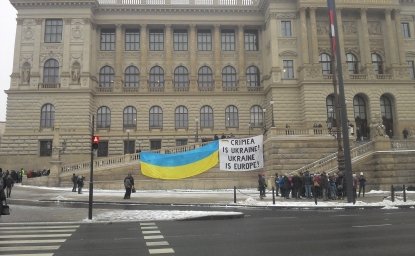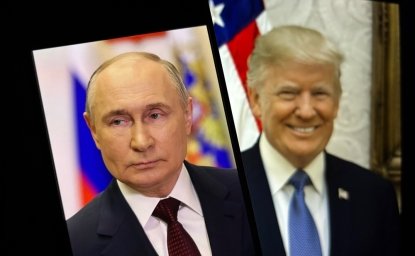Robust Revolution to Retiring Revolution: The Life Cycle of the Soviet Revolution, 1945-1968

"Very few leaders in history were associated so closely with the movement they led and the state they built than Stalin," said Amir Weiner, associate professor of history and co-director, Center for European Studies, Stanford University, and former Title VIII-supported research scholar, Kennan Institute. Speaking at a 1 November 2007 Kennan Institute talk, Weiner analyzed the fate of the Soviet Revolution both after World War II and in the years following the death of Stalin.
Weiner noted that while ultimate goals of the revolution remained constant during this period, the revolution's underlying institutional pillars were subject to change. Weiner identified the three fundamental pillars of Stalin's Soviet Union: single party dictatorship, with its unique bifurcation of party and state; a non-market economy; and mass state terror. According to Weiner, the war introduced confusion in Soviet policy, with hints of liberalization in the arts, agriculture, the relationship with the West, etc. However, when Stalin finally addressed the lessons from the war in 1947, he saw in them a confirmation of the strength, stability, and justice of the Soviet system. Communism literally appeared just around the corner, but before achieving this objective, certain remaining impediments had to be addressed. As a result, argued Weiner, Stalin ratcheted up the level of terror to the maximum, culminating in the racist campaign against Soviet Jews during the Doctor's Plot. Stalin further reinvigorated the utopian drive in the economic sphere, calling for the end of collective farm property and commodity exchange.
Stalin's death and subsequent succession crisis caused the Communist Party to re-examine the fundamental pillars of the revolution itself. Weiner described the broad consensus among the competing leaders; they agreed to retain the single party dictatorship and command economy, but to renounce the use of mass terror. At the same time, Weiner noted there was a profound policy disagreement within the Soviet leadership over the relationship between the party and the state. In 1953 Malenkov and Beria advanced the idea of creating super-ministries, thereby increasing the power of the state at the expense of the party. Malenkov and Beria's proposal, however, provoked an unexpected response from the national republics and the USSR's western borderlands. Many national minorities—Weiner cited Lithuanians, Latvians, Ukrainians specifically—perceived this proposal as the first steps in the abolishment of the party and possible dissolution of the Soviet Union. As a result, Stalin's successors discarded the initiative and reasserted the supremacy of the party, ultimately serving as the glue that kept this supra-national state together. "And so [the Communist Party] stayed," added Weiner, "until the very end, until it was undone by a masterful tactician and clueless strategist and very poor student of Soviet history named Mikhail Gorbachev."
Weiner described the initial excitement that accompanied the thaw, with its call for increased openness and apparent willingness to deal with the past. At the same time, noted Weiner, there were certain underlying continuities between Stalin's and Khrushchev's policies, most notably in Khrushchev's attempt to jump start the utopian drive of the Soviet revolution. In many instances, Weiner argued, one could identify Stalin's blueprints for Khrushchev's policies. For example, Khrushchev's 1959 utopian plan envisioning communism within 20 years was by and large a dusting off of the party program of 1947. Weiner added that the mobilization of the population in policing itself also had utopian roots that went back to the Red Guards in 1917 and Lenin's original vision of communism. Finally, Weiner noted that Khrushchev once again sought to rely on class origin as the main determinant in pushing the Soviet Union's utopian agenda.
Weiner questioned whether Khrushchev and the Communist Party would have been capable of maintaining this utopian drive, especially after they had rejected the use of mass terror. According to Weiner, there was a general recognition that the Soviet population would not mount active resistance against the regime, as it was itself exhausted by decades of war and revolution. Weiner added that following World War II, the authorities also had more confidence and trust in local cadres. Nevertheless, Weiner emphasized that the Soviet Union already lacked certain key elements to sustain a utopian drive in the 1950s. First, Weiner emphasized that a continuing problem was the significant gap between utopian claims and Soviet reality. Second, the Soviet Union's post-war sphere of influence was also a source of destabilizing information, especially for Soviet youth. The loss of authority of Soviet leadership both at home and abroad also discredited any utopian drive. Finally, according to Weiner, the Soviet Union found itself on the defensive abroad—in Romania, Hungary, Czechoslovakia, and most notably China—developments that could never have been contemplated under Stalin and which dramatically limited any domestic utopian urge.
Thus, Weiner described the 1950s Soviet system as already archaic and slowly grinding to a halt, based more on bluffing rather than genuine positive actions on the part of its leadership or in society. By the 1960s, Weiner concluded, the Soviet man was no longer a utopian knight rushing to save humanity. Instead, after five decades of mayhem and bloodletting, the best that the Soviet system could offer was an end to terror and a minimum level of economic and political stability.
Author


Kennan Institute
After more than 50 years as a vital part of the Wilson Center legacy, the Kennan Institute has become an independent think tank. You can find the current website for the Kennan Institute at kennaninstitute.org. Please look for future announcements about partnership activities between the Wilson Center and the Kennan Institute at Wilson Center Press Room. The Kennan Institute is the premier US center for advanced research on Eurasia and the oldest and largest regional program at the Woodrow Wilson International Center for Scholars. The Kennan Institute is committed to improving American understanding of Russia, Ukraine, Central Asia, the South Caucasus, and the surrounding region through research and exchange. Read more

Explore More
Browse Insights & Analysis
The OSCE is a Good Value for America

Infographic | Russia's Illegal Annexation of Crimea

Russia’s Indigenous Communities and the War in Ukraine
